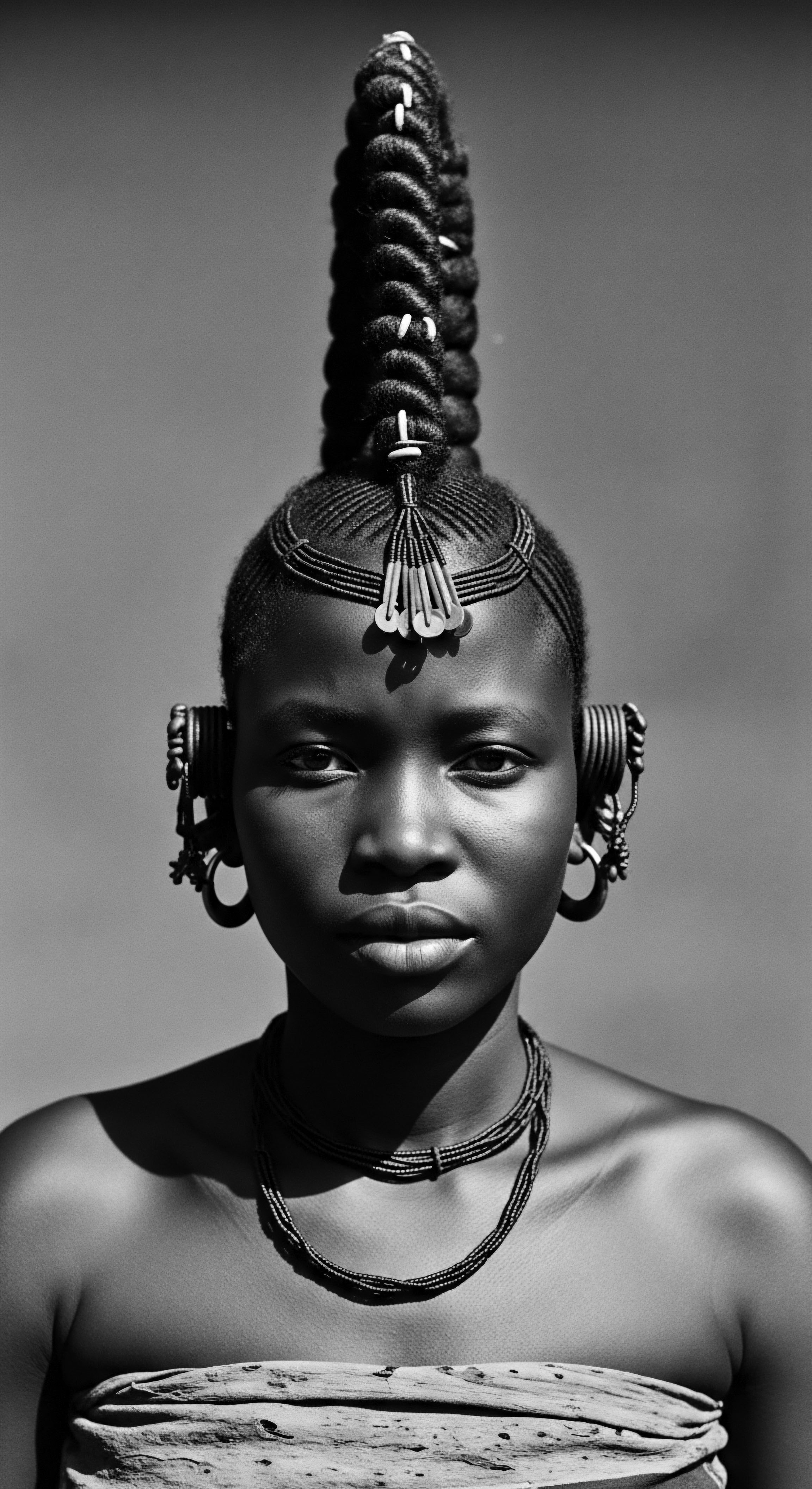
Roots
Hearken, gentle seeker of wisdom, to the whispers carried on ancient currents, whispers that speak of soil and sun, of hands tending crops, and of the profound connection between sustenance and the very fiber of our being. We stand at the threshold of understanding how the Earth’s bounty, honored through generations of careful practice, safeguarded the vibrant, diverse expressions of textured hair. This exploration is not a mere recounting of facts; it is a pilgrimage into the soul of a strand, tracing its lineage through kitchens and communal feasts, back to the elemental sources that bestowed its enduring strength.
The foundation of resilient hair, we find, was laid long before the advent of modern science. It was understood through observation, through the living archive of bodies sustained by land and tradition. For communities across Africa and its diaspora, where textured coils and kinks were the norm, the relationship between diet and dermal health, including the scalp and its precious follicles, was intuitively grasped.
Our ancestors, acutely attuned to the rhythms of nature, recognized that a diet rich in certain natural compounds bolstered the very structure of the hair shaft, offering an internal shield against the rigors of existence. This deep, ancestral knowledge formed the bedrock of practices that served to protect and preserve hair for the children, and for the children’s children.
Ancient food customs offered internal nourishment, shaping textured hair’s resilience for generations.

What Sustenance Defined Early Hair Health?
Consider the staple foods that dominated diets in many traditional African societies ❉ nutrient-dense grains, tubers, leafy greens, and pulses. These were not just calories; they were powerhouses of the building blocks essential for keratin, the primary protein of hair. The consumption of grains such as millet and sorghum , for instance, prevalent in many West African regions, provided a steady supply of complex carbohydrates, crucial for energy production within hair follicle cells. Furthermore, these grains often contained trace minerals like zinc and iron, both indispensable for healthy hair growth and preventing shedding (Rushton & Dover, 1999).
Beyond grains, indigenous vegetables, often wild-harvested, played a paramount part. Think of the amaranth leaves or African spinach , consumed widely across the continent. These greens were not simply side dishes; they were concentrated sources of vitamins A and C, vital for sebum production and collagen synthesis around the follicle, respectively.
Sebum, the natural oil produced by the scalp, plays a critical part in lubricating and shielding textured hair, which, due to its unique coiling pattern, is more susceptible to dryness and breakage. The consistent internal provision of these vitamins meant a consistent, healthy flow of natural moisturizers, contributing to the hair’s structural integrity.
Moreover, the traditional reliance on healthy fats from natural sources, such as palm oil or shea butter (consumed internally as part of meals, not just applied topically), contributed significantly. These fats offered essential fatty acids, which fortify the cell membranes of scalp and hair cells, imparting pliability and preventing brittleness. The lineage of this knowledge, passed from elder to youth, ensured that the lessons of the land translated directly into the vitality of the strands.

How Did Traditional Food Processing Shield Hair?
The methods of food preparation themselves carried a silent wisdom, acting as a further layer of protection. Fermentation, for example, a common practice for many traditional grains and vegetables, did more than preserve food; it enhanced nutrient bioavailability. When grains or legumes were fermented, their phytate content, which can inhibit mineral absorption, was reduced, making the essential zinc, iron, and B vitamins more accessible to the body, and by extension, to the hair follicles.
Soaking and sprouting practices also played similar roles, ensuring that the full nutritional potential of foods was unlocked, creating a continuous internal wellspring for hair health. This ancestral ingenuity minimized nutritional deficits that could otherwise weaken the hair.
The communal aspect of these customs also played an unwritten but significant role. Shared meals, often prepared with reverence, solidified social bonds and ensured the transfer of knowledge about which foods, and which preparation methods, sustained the community’s overall wellbeing, including their visible crown of hair. It was a holistic approach, where the body, the community, and the Earth were recognized as interconnected.
| Food Staple Millet/Sorghum |
| Ancestral Benefit for Hair Provided sustained energy and trace minerals for growth. |
| Modern Scientific Link Rich in B vitamins, iron, and zinc; supports keratin synthesis and cell division. |
| Food Staple Leafy Greens (e.g. Amaranth) |
| Ancestral Benefit for Hair Boosted natural scalp oil production and follicle health. |
| Modern Scientific Link High in Vitamins A and C, antioxidants, crucial for sebum and collagen. |
| Food Staple Palm Oil/Shea Butter (internal use) |
| Ancestral Benefit for Hair Imparted internal lubrication and pliability to hair strands. |
| Modern Scientific Link Source of essential fatty acids and Vitamin E, fortifying cell membranes and reducing oxidative stress. |
| Food Staple Fermented Grains/Legumes |
| Ancestral Benefit for Hair Enhanced nutrient absorption, preventing deficiencies. |
| Modern Scientific Link Improved bioavailability of minerals and B vitamins due to reduced anti-nutrients. |
| Food Staple These customs highlight a deep, intuitive understanding of nutritional science within ancestral communities, demonstrating how diet directly bolstered hair health. |

Ritual
From the fertile ground of nutritional understanding, ancient practices bloomed into intricate rituals, transforming the act of sustenance into a tender act of care for textured hair. These were not merely dietary habits; they were formalized customs, woven into the fabric of daily life and special occasions, ensuring that the hair, often regarded as a conduit to the divine or a marker of identity, received consistent, heritage-informed protection. The internal nourishment provided by specific foods was often complemented by their external application, blurring the lines between consumption and cosmetic care.
The wisdom of these rituals speaks to an acute observation of hair’s needs. Textured hair, with its unique helical structure, requires particular attention to moisture retention and structural integrity to resist breakage. Our ancestors, through trial and generational observation, discovered that certain food-derived substances, when applied directly, offered unparalleled conditioning and strengthening properties. These applications became sacred practices, passed down through the gentle touch of mother to child, elder to kin, preserving not just hair, but a legacy of care.
Rituals blended internal nourishment with topical applications, creating a heritage of holistic hair protection.

How Did Food Become Topical Treatment?
Consider the widespread traditional use of shea butter across West Africa, derived from the nuts of the shea tree. While we discussed its internal consumption for healthy fats, its external application as a deeply conditioning agent is equally significant. Women would often process the nuts into a rich, creamy butter, which was then massaged into the scalp and along the hair strands.
This ritual, often performed during evening gatherings or before protective styles, provided an unparalleled barrier against moisture loss, sealing the cuticle and imparting a soft pliability to the hair (Fleming, 2012). The fatty acids and vitamins A and E present in shea butter mimicked, in a way, the natural sebum production, supplementing it for hair types that needed extra fortification against the elements.
Similarly, the use of various plant-derived oils, such as coconut oil in coastal communities or argan oil in North Africa, served a protective function. These oils, extracted through laborious traditional methods, were more than just lubricants; they were believed to penetrate the hair shaft, reducing protein loss during washing and handling. The ritual of oiling, often preceding hair manipulation or as a daily sealant, demonstrated a deep understanding of the hair’s need for sustained moisture and reduced friction—a critical strategy for preventing tangles and breakage in textured hair. These applications formed a living science of care, rooted in the available natural pharmacopeia.

What Were Communal Practices for Hair Fortification?
Many hair care rituals, especially those connected to food customs, were deeply communal. The act of preparing and applying these nourishing substances often involved multiple generations, cementing the transfer of knowledge and reinforcing the cultural value placed on healthy hair. For example, in some communities, older women would teach younger girls the art of preparing specific herbal rinses or conditioning masks from local plants and food remnants, such as rice water for strength and shine (a practice also seen in East Asian cultures, but with distinct cultural adaptations within African diasporic communities for textured hair). These shared moments, steeped in storytelling and song, transformed a practical necessity into a powerful expression of collective identity and cultural continuity .
Another fascinating practice involved the use of mucilaginous plants, often for their thickening and detangling properties. Think of the use of okra or flax seeds (though flax seeds gained broader recognition later, similar mucilage-rich plants were certainly known). When boiled or soaked, these plant components release a slippery gel, which, when applied to hair, acted as a natural detangler and humectant.
This allowed for gentler manipulation of delicate coils and kinks, significantly reducing mechanical damage during styling and cleansing. The preparation of these concoctions was often a ritual in itself, involving precise measurements and specific timings, reflecting a nuanced understanding of their chemical properties long before laboratories could isolate active compounds.
- Shea Butter ❉ A revered emollient, traditionally consumed and applied, sealing moisture into textured strands.
- Coconut Oil ❉ Used for deep conditioning and preventing protein loss during ancestral hair cleansing rituals.
- Rice Water ❉ A historical rinse that fortified hair, a tradition adapted and integrated across various cultures for strength and luster.
- Mucilaginous Plants (e.g. Okra, certain barks) ❉ Provided natural slip for detangling, protecting delicate coils from breakage during manipulation.
| Practice Rooted in Food Custom Shea Butter Application |
| Traditional Context Daily moisturizing, pre-styling, children's hair care. |
| Hair Protection Mechanism Forms a protective barrier, seals moisture, prevents environmental damage. |
| Practice Rooted in Food Custom Plant Oil Oiling (e.g. Coconut, Argan) |
| Traditional Context Before washing, daily sealing, scalp massage. |
| Hair Protection Mechanism Penetrates shaft, reduces hygral fatigue, adds pliability, minimizes protein loss. |
| Practice Rooted in Food Custom Mucilage-Rich Plant Rinses |
| Traditional Context Detangling, conditioning, post-cleansing treatment. |
| Hair Protection Mechanism Provides slip for gentle manipulation, reduces friction and breakage. |
| Practice Rooted in Food Custom Herbal/Spice Pastes (e.g. Fenugreek) |
| Traditional Context Scalp treatments, strengthening masks. |
| Hair Protection Mechanism Delivers nutrients, stimulates circulation, fortifies follicles from the outside. |
| Practice Rooted in Food Custom These rituals, born from ancestral ingenuity, demonstrate sophisticated protective strategies for textured hair, blending local resources with a deep understanding of hair needs. |

Relay
The wisdom embedded within ancient food customs, once a murmur among the village elders, has traveled across continents and generations, often whispering its truths through the storm of history. The relay of these practices, particularly those that shielded textured hair, stands as a testament to the enduring power of ancestral knowledge and the resilience of a people. This transmission was rarely linear; it adapted, absorbed new influences, and sometimes, went underground, only to resurface with renewed vigor, always carrying the indelible mark of its heritage. Understanding this relay means recognizing the adaptive brilliance of communities in preserving their very identity through their hair.
In the shadow of forced displacement and cultural disruption, the commitment to nurturing textured hair through food-derived rituals became an act of quiet defiance, a way to maintain connection to a past violently severed. The nutritional principles gleaned from centuries of observation—the importance of specific vitamins, minerals, and fatty acids for hair integrity—were subtly integrated into new environments, using available resources. This continuous adaptation, while preserving the core intent of hair protection, allowed these customs to survive, becoming a living, breathing archive of resilience and identity.
The relay of ancestral food customs for hair health, enduring through historical shifts, became a powerful act of cultural preservation.

How Did Nutritional Wisdom Persist Through History?
The transatlantic slave trade, a period of unparalleled upheaval, presented immense challenges to the continuity of cultural practices. Yet, even in the harshest conditions, remnants of ancestral dietary wisdom persisted. Enslaved Africans, often subjected to inadequate and unfamiliar provisions, instinctively sought out wild plants or adapted traditional cooking methods to maximize the nutritional yield of their limited rations (Carney & Rosomoff, 2009). The knowledge of which plants provided internal strength for the body, and by extension, for the hair, was verbally passed down, subtly integrated into new culinary landscapes.
For instance, the enduring popularity of nutrient-dense greens like collards, mustard greens, and turnip greens in African American cuisine can be seen as a direct lineage of the ancestral reliance on leafy vegetables for vital vitamins and minerals, which underpinned hair health. These greens, prepared with fatty meats (a survival adaptation), provided internal nourishment that, though altered, continued to support keratin production and overall bodily vigor.
Furthermore, the resourcefulness of enslaved and later, freed communities, led to the creative re-purposing of food by-products for external hair care. The water left from boiling rice or cornmeal, rich in starches and some nutrients, could be used as rinses. Leftover animal fats, after being rendered for cooking, sometimes found their way into rudimentary hair pomades, offering a protective barrier.
While these adaptations were born of scarcity, they illustrate the deep-seated understanding that what sustained the body could also sustain the hair, keeping alive the principles of nourishing the strands from the inside out and the outside in. This quiet, persistent innovation allowed the heritage of hair care to adapt and survive.

What Scientific Validation Supports These Ancient Practices?
Modern nutritional science increasingly offers validation for these long-standing food customs. We now understand, with biochemical precision, why those ancient dietary choices bolstered hair health. For example, deficiencies in certain nutrients, such as iron, zinc, and biotin, are now well-documented causes of hair loss and compromised hair structure (Almohanna, Ahmed, Tsatalis, & Tosti, 2019).
The consistent intake of millet, leafy greens, and legumes by ancient populations provided these very elements, preventing the deficiencies that lead to common hair ailments. This scientific lens does not diminish the ancestral wisdom ; rather, it highlights its intuitive brilliance.
The practice of using food-grade oils, like coconut oil, for hair applications, finds support in research showing its ability to reduce protein loss in hair due to its unique molecular structure, which allows it to penetrate the hair shaft. Similarly, the humectant properties of plant-based gels are now understood through the lens of polysaccharides and amino acids, which attract and hold moisture, crucial for the hydration of textured hair. This bridge between ancient custom and contemporary science allows us to appreciate the sophistication inherent in what might have seemed like simple, daily routines. The transmission of this knowledge, from generation to generation, has ensured that the wisdom of the past continues to illuminate the path for future hair care.

Reflection
To gaze upon a strand of textured hair, then, is to witness a living memory, a repository of journeys taken, wisdom gathered, and resilience embodied. The ancient food customs that protected this hair for future generations are more than historical footnotes; they are the very lineage of its strength, a quiet testament to the ingenuity and profound understanding held within our ancestral heritage . These practices, whether through the internal alchemy of nutrient-rich diets or the tender alchemy of topical applications, speak to a holistic philosophy of wellbeing where hair was never isolated from the body, the community, or the Earth itself.
In this grand, living archive, the “Soul of a Strand” resonates with the echoes of ancient kitchens, communal rituals, and the enduring spirit of adaptability. It reminds us that our hair is not merely an aesthetic choice, but a profound connection to a lineage of care, a vibrant affirmation of identity, and a continuous conversation with the wisdom passed down through time. Each curl, each coil, carries the legacy of nourishment, protection, and boundless spirit, guiding us to remember the powerful, often understated, ways our ancestors ensured our crowns would forever speak of survival, beauty, and unyielding heritage .

References
- Almohanna, H. M. Ahmed, A. A. Tsatalis, E. L. & Tosti, A. (2019). The Role of Vitamins and Minerals in Hair Loss ❉ A Review. Dermatology and Therapy, 9(1), 51-70.
- Carney, J. A. & Rosomoff, R. N. (2009). In the Shadow of Slavery ❉ Africa’s Botanical Legacy in the Atlantic World. University of California Press.
- Fleming, E. (2012). The Book of Afro Hair. Thames & Hudson.
- Rushton, D. H. & Dover, R. (1999). An analysis of the trichological and nutritional changes in 180 cases of hair loss. Journal of Cosmetic Dermatology, 2(3), 114-123.
- Nwosu, M. O. (2010). Traditional African Food Systems and Their Sustainability. Journal of Human Ecology, 30(2), 125-131.
